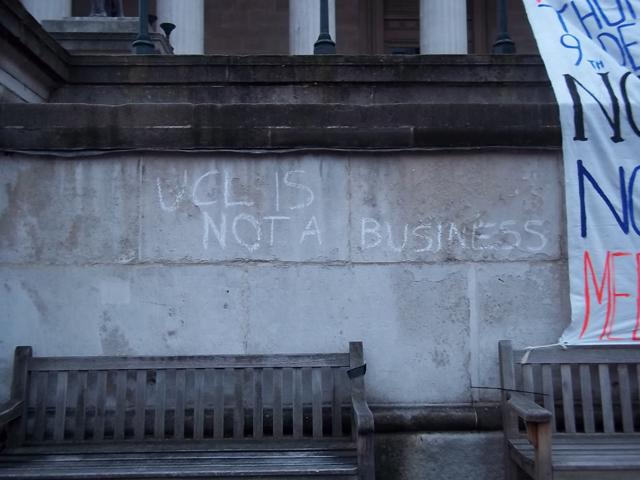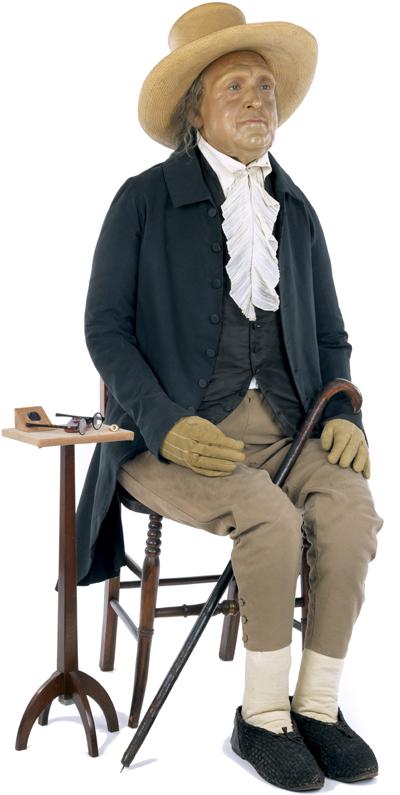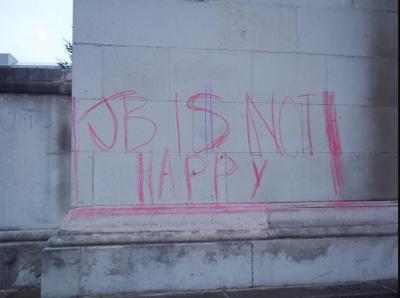Earlier this year, academics at 65 UK universities were on strike for fourteen days over proposals of cuts to the Universities Superannuation Scheme (USS), the sector’s pension fund. Institute of Archaeology (IoA) striking staff organised a series of activities to keep students engaged during this period. This included the making of an all-hands’ banner, named ‘hands-up for education’ inspired by Magdalenian cave paintings (Figure 1). While the Magdalenian paintings were made by blowing pigment on hands held against the cave walls, ours was made by spraying acrylic paint on hands neatly protected by nitrile gloves.
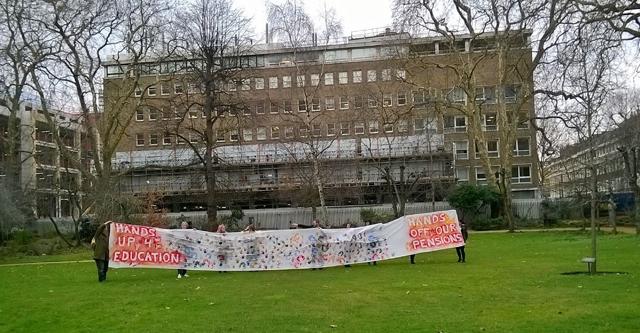
The ‘hands-up for education’ banner, inspired by Magdalenian cave paintings, 23rd February 2018 (Photo: Renata F. Peters).
Another highlight was the teach-out ‘Archaeology of Strikes and Revolution’, which took place on our steps on the 13th March, and was motivated by a desire to draw parallels to the history of strikes and revolts and elaborate on the impacts of these movements. Seven speakers offered personal reflections and case studies for debate with colleagues, students and passers-by (Figure 2). We started with David Wengrow, who discussed the possible origins of work strikes. Stephen Quirke followed with a case study from Late Bronze Age Egyptian documents. Yagmur Heffron (UCL History), discussed Middle East archaeology and history using a case study from Turkey. Renata F. Peters followed with a discussion on the perceptions of vandalised material associated with revolt. Beverley Butler explored the role played by UCL’s heritage in the 2018 strike. The session concluded with Ulrike Sommer discussing a case study of ancient Rome and Mike Rowlands starting a lively discussion. Below you see more details on some of these contributions.
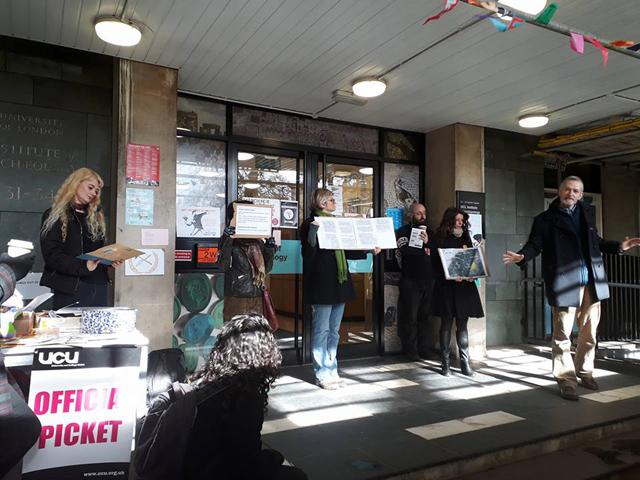
Teach-out ‘Archaeology of strikes and revolution’ on the steps of the UCL Institute of Archaeology, 13th March 2018 (Photo: Mariana Peters Olivio).
A note on strikes and revolutions in archaeology (David Wengrow)
One of the building blocks of what V. Gordon Childe called the Urban Revolution was the institution of corvée labour. Standard definitions of corvée refer to forced labour on civic projects, extracted by the state from free citizens on a periodic basis. The authors of ancient Mesopotamian literature, the world’s oldest literature, would certainly have recognised this definition. Atrahasis, the Mesopotamian flood myth and precursor to the biblical story of Noah, recounts how the gods created people specifically to perform corvée labour that they themselves were tired of doing. (Mesopotamian gods were unusually “hands-on”). Digging and clearing irrigation canals seems to have been a particular source of irritation. In fact, we are told, the gods first created lesser gods to do it, but they too quickly rebelled and went on strike: and hence the creation of people, to do the necessary work of the gods.
So, from a Mesopotamian point of view, work strikes—and the right to withhold labour—existed from the beginning of time: without them, we humans would not exist. And, for all time thereafter, even the most powerful rulers of Mesopotamian cities still had to legitimise their status by heaving a basket of clay to the construction site of a temple, a solemn ritual duty, signifying the equality of all mortals before the gods. So much for strikes.
What about revolutions? When Gordon Childe talked about an Urban Revolution, taking place in the ancient Near East around 5000 years ago, he was thinking of things like the origins of specialised crafts and industries, monumental architecture, taxation, and monarchy. But all this, he supposed, happened more or less unconsciously, as an inevitable result of demographic growth, after the first Revolution – the Neolithic one. Strangely, for a Marxist, he did not consider much the possibility of political revolution in the world’s first cities: the conscious overturning of a given political order. The Urban Revolution was all supposed to be part of our species’ inevitable march towards inequality.
Even today, the picture we present of the first cities can seem weirdly static. We look at a two-dimensional plan of Mohenjo-daro or Teotihuacan, and what we are really seeing is the compression of five or more centuries of history into a flat montage. Imagine trying to extract history from a similar image of the centre of Paris, taking in – at a single compressed glance – the foundation levels of the entire ancien régime and post-Revolutionary city. If we would not look at modern cities this way, then why ancient ones? Is it really plausible that social life in our earliest known cities was so static, so immutable for half a millennium or more?
In Mohenjo-daro’s case, we know this was not so. At least two centuries before the city’s demise, it’s ‘Great Bath Complex’ had already fallen out of use. Industrial facilities and residential housing crept beyond the Lower Town, into the heart of the Upper Citadel, even into the former site of the Great Bath itself. This “other” Mohenjo-daro existed for generations. Its archaeological description as the site’s ‘Late Period’ hardly does it justice. The label implies something of an afterthought, rather than the conscious transformation of a centuries-old pattern of hierarchy.
Such loaded terminology has influenced the interpretation of early cities elsewhere. The tendency is to cast them in a false organic light: formative flowerings of urban culture, growing to maturity, and eventually withering on the stem. But closer inspection often reveals evidence of radical internal transformations—urban revolutions of the political kind—which defy any such organic or evolutionary scheme. Typically, the words used to describe those periods (“intermediate”, “post-classic”, or even “terminal”) serve to disguise their historical character, making them sound more like deviations from an ideal pattern of growth (often to be blamed on a run of bad weather, or “climate change”, to continue the organic metaphor). Social transformations after the end of Egypt’s Old Kingdom, or of the Classic Maya, suffer the further ignominy of being labelled “civilizational collapse”, when all that was really collapsing was a prevalent class structure, while other aspects of civilisation—trade, domestic religion, local political structures—actually flourished. High stakes attend such terminological battles. We are playing for nothing less than what George Kubler called the “shape of time”.
Let me finish with a particular striking example, of just how politically dynamic some of the earliest cities could be. This time China. Long before the Shang dynasty, and long before the invention of writing, cities already existed in China. One of them, called Taosi, lies near the modern confluence of the Yellow and Wei Rivers. Between 2300 and 1800 BC, it went through three phases of expansion. In the early and middle phases, Taosi exhibits monumentality and stratification almost worthy of some later imperial capitals. Commoners lived apart from elites. There were palaces, massive enclosure walls, road systems, and large protected storage areas. Burials in the municipal cemetery could be clearly divided into ranked classes. But then, around 2000 BC, everything changed.
Here’s the excavators’ description of what happened at Taosi:
The city wall was razed flat, and … the original functional divisions destroyed, resulting in a lack of spatial regulation. Commoners’ residential areas now covered almost the entire site, even reaching beyond the boundaries of the middle-period large city wall. In addition, the ritual area in the south was abandoned. The former palace area now included a poor quality rammed-earth foundation, surrounded by trash pits used by relatively low-status people. Stone tool workshops occupied what had been the lower-level elite residential area. The city clearly had lost its status as a capital, and was in a state of anarchy.
Now, two points seem important to note. First, the ‘state of anarchy’ (or ‘collapse and chaos’ as another Chinese archaeologist describes it) lasted almost as long as the entire duration of the earlier city. Second, the overall size of Taosi actually grew at this time from 280 to 300 hectares, suggesting prosperity, not collapse, after the removal of a rigid class system.
To take just one more example: around 200 AD, the city of Teotihuacan in the Valley of Mexico, with a population of 120,000 (one of the largest in the world at the time), appears to have undergone a profound transformation, turning its back on pyramid-temples and human sacrifice, and reconstructing itself as a vast collection of comfortable villas, almost all exactly the same size. It remained so for perhaps 400 years. Even at the time of the Spanish conquest, Central Mexico was still home to cities like Tlaxcala, run by an elected council who were periodically whipped by their own constituents, just to remind them who was ultimately in charge. We still have much to learn from history.
Late Bronze Age Egyptian documents (Stephen Quirke)
The best documented work dispute from second millennium BC Egypt takes place on the West Bank at Thebes (modern Luxor) at the time of Ramses III (c. 1150BC), when a crew of 40–60 hungry and discontented artists (draughtsmen, painters, sculptors) employed on the tomb of the king in the Valley of the Kings, start a sit-down strike on a main road near a central temple in the landscape. Their demonstrations continue for months, escalate, gain important allies, deteriorate but also win the group a few victories. Despite its partiality and fragmentary condition, this written record conveys the collective and individual tensions permeating archaeological landscapes. The ancient world can prompt a further rethink of our use of phenomenology at sites of tangible power. Today Luxor is one of the largest monument fields in the world; the ancient demonstrators invite us to return to the harmonious architecture, and, alongside exploring its ethereal and aesthetic powers, not to miss the layers of action and hesitation to our experience.
Fast forward thirty centuries to the 1810s: Egypt is part of the Ottoman Empire, and its strong-willed governor Muhammad Ali, from Albania, is on good terms with radical adventurer Bernardino Drovetti, who had helped him stop a British invasion. Drovetti is assembling the first large Egyptian antiquities collection; the villagers of Qurna skilfully apply their knowledge of their home landscape to unearth ancient objects for his agents, including the papyrus with the most extensive record of the strikes. In 1824 craftsmen of the region rise up against the impact of imports and taxes on their lives. That year Drovetti concludes the sale of his collection to Carlo Felice king of Sardinia, creating the core of a new Egyptian Museum in Turin. The papyrus is today often called the Turin Strike Papyrus, an association of words which the further history of the city justifies more than most such archaeological names. For, a century later, Turin itself is the scene for the mass strikes and factory occupations of the Biennio Rosso during the revolutionary and counter-revolutionary turmoil after the First World War. In 1919, strikes and demonstrations equally marked the revolution that year in Egypt against British occupation. Maybe newspapers and letters of these modern struggles already contain reflections on connections across time and land in a virtual conversation between the 1186BC artist, the 1824 weaver, and the 1919 mechanic.
There is a lively account of the ancient Egyptian strike documents in chapter 2 of Affairs and Scandals in Ancient Egypt (Vernus 2003), and an extensively illustrated website on the Strike Papyrus at https://dianabuja.wordpress.com/2012/03/16/food-strikes-in-ancient-egypt-the-turin-strike-papyrus-etc/. The work disputes in 19th- and 20th-century Egypt are discussed by John Chalcraft in Popular Politics in the Making of the Modern Middle East (2016) and Striking Cabbies of Cairo and Other Stories (2012).
Material heritage associated with protest, revolution and revolt (Renata F. Peters)
Values associated with material heritage may change drastically and what is perceived as worth of preservation today may be perceived as deserving to be vandalized tomorrow, and vice-versa. Similarly, perceptions of ‘damage’ or ‘unsolicited interventions’ vary along time, depending on the socio-political context in which they are inserted or who has access to decision-making and interpretation. Here I use historic examples associated with protest, revolution and revolt to explore these variations and some of their impacts.
A portrait of Peter II on display at Museu Histórico Nacional (National Historic Museum) in Rio de Janeiro, Brazil, illustrates the work of conservators being used to consolidate specific views of history (Figure 3). Peter II, the last ruler of the Empire of Brazil, was overthrown by a military coup in 1889 when a republican regime was established. The portrait, whose author is unknown, was slashed in the Cabinet of War following the republican coup. The damage is still visible today although a skilful conservator could easily ameliorate the appearance of the portrait by, for example, in-painting the area that has been repaired. The damage, however, seems to have acquired unexpected value as the symbolic act of slashing Peter II’s face is probably the reason why this otherwise unremarkable painting is on display today. The question here is whether this painting would be conserved differently had the royalty remained in power in Brazil.
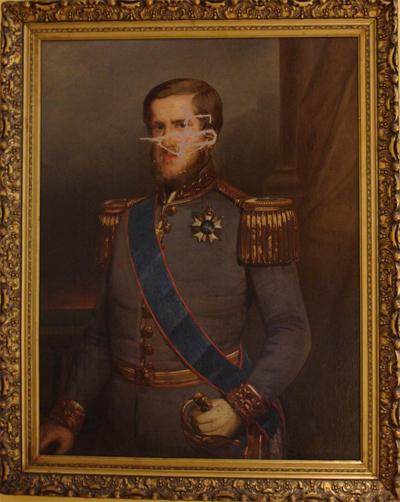
Portrait of Peter II on display at Museu Histórico Nacional, Rio de Janeiro, Brazil. Oil on canvas, 115 × 88 mm. Unknown author (c.1858). (Photo credit: Museu Histórico Nacional, Ibram, MinC, Reference n°19/2018).
A similar example is found at the Museo de la Revolución (the Revolution Museum), in La Havana, Cuba. The museum is housed in Fulgencio Batista’s former official residence, the president overthrown by the Fidel Castro’s revolutionary movement in 1959. One of the main walls of the museum holds bullet holes made during its invasion, which now receive the same attention as other objects in the museum. In this case, not only was the damage objectified – it was also preserved so as to illustrate the end of a political era.
The toppling of Saddam Hussein’s statue in Baghdad’s Firdos Square in April 2003 was largely publicized under a positive light by the western media at the time, and even presented as a symbol of the end of the Iraq war. The war, however, lasted eight more years. By its official end in November 2011, it had claimed almost 5,000 lives from the coalition states and over 109,000 civilians, insurgents and Iraqi security forces (Rogers 2011). Thus, perhaps it is not surprising that perceptions of the toppling have changed considerably since 2003. Today they range from those who accuse the US military of having staged and orchestrated it (Zucchino 2004) to those who think its significance was inflated (Maass 2011).
In 2012, Mr. Nigel Ely, a former soldier from Britain’s SAS regiment who was guarding a camera crew during the toppling, was arrested for having brought a fragment of the statue (described as part of Saddam’s left buttock) to the UK, where he tried to have it auctioned (The Telegraph 2012a). The arrest followed a complaint made by officials from the Iraqi embassy in London, according to whom the fragment is part of Iraq’s “cultural antiquity” (The Telegraph 2012b). The former soldier, on the other hand, claimed the statue was “just a piece of scrap metal” when he got it, and added that he was trying to raise money for military charities. Mr. Ely also offered curious insight on the difference between history and cultural property by saying that “This is like having a chunk of the Berlin Wall – it’s part of history but it’s not cultural property” (Nigel Ely, cited in The Telegraph 2012b).
The 2010 student protests against the marketization of HE and the incorporation of tuition fees offer an almost poetical opportunity to conclude this brief discussion. During the first week of November 2010, a number of protest chalk graffiti mysteriously appeared on the walls of the main UCL campus (CCCH 2010). The perceptions of the chalking were divisive among UCL students and staff. At one end there were those who saw the need to criminalize the action, as it might have seriously damaged UCL historic walls. But there were also those who thought the graffiti represented UCL’s vibrant environment and protesters had the right to express their views. Regardless, everything dissolved in London rain a few weeks later, as quietly as it had materialized. Some of the messages, however, may still resonate today (Figure 4).
Subverting the Ancestors – Critical Heritage Perspectives on UCL Protests and Strikes (Beverley Butler)
UCL’s heritage and the heritage of particular departments and disciplines – along with ‘founding’ ‘father’ figures, and importantly women too – were powerful elements of the 2018 strike and protests. What interests me is the insight this offers more generally into how institutions and groups return to origins, ancestors and foundational moments within archival memory in its extended sense. Intriguingly, this process of repossession is entered into as a means of often radically transforming such dynamics, recasting them in order to highlight how the same origins, founding moments, icons and personas can be taken in different directions.
This strategic return to institutional archive also appeals to collective memory and solidarity, belonging and has its own politics of recognition, legitimation and truth value. To achieve this effectiveness subverting the ancestors and ancestry taps into much needed humour, irony and play. It is a process, however, that seeks to draws out contestation and conflict. Below, I briefly look at how the heritage of UCL and of the IoA illustrate how different trajectories can be pursued while demonstrating that this heritage of repossession has its own depth of heritage often founded upon ‘invented tradition’.
‘Spiritual Father’ – UCL’s Auto Icon
My first route concerns Jeremy Bentham: famous ‘auto icon’ and UCL’s ‘spiritual father’ (Figure 5). During UCL’s history Bentham’s persona has been taken up to offer very different trajectories that show how UCL’s origins are a potent combination of myth-history and a means to iterate contrasting genealogies, ethics and futures. First, there is an official dominant narrative that casts UCL as fulfilment of Bentham’s vision of what a University should be: an embodiment of the ideal of public education synonymous with the ‘greatest good for the greatest number’. Here too the link between education and/as wellbeing and the vision of self-fulfilment and the fulfilment of society as mutually supporting/constituting entities are underscored. This enlightened tradition thus complementing the university’s pedigree-cum-mantra as a non-conformist alternative to Oxbridge and as ‘the first English University to open its doors to all, regardless of race, creed or political belief’. This makes our ancestors/origins utopian on a symbolic level. In official narrative a certain insistence on pressing Bentham into the service of UCL sees the deployment of ‘invented history’ in its extreme. The tradition – proven to be inaccurate – that Bentham has a history of being wheeled into UCL Board Meetings on the ironic understanding the auto-icon is ‘present but not voting’ has quite recently become fulfilled. This was the occasion when former provost Malcolm Grant on his retirement created the scenario. The London Metro covering this story led with the sardonic title ‘181-year-old corpse of Jeremy Bentham attends UCL board meeting’ reporting that:
‘Many board meetings are so tedious that members often end up looking like waxwork dummies. But at this gathering, the well-dressed gentleman in the corner can be forgiven for looking a little out of it – Jeremy Bentham died 181 years ago’. The ‘spiritual founder’ of University College London can usually be found in a cabinet in a university corridor. But he was moved earlier this week to mark the last council meeting attended by retiring provost Sir Malcolm Grant (Smallman 2013)
‘JB is not happy’ – Repossessing ‘Uncle Jeremy’
A second trajectory sees the image of Jeremy Bentham as a figure of subversion, and co-opts ‘Uncle Jeremy’ playfully, as parody, thereby creating a sense of solidarity and repossessing him as a means to speak ‘truth to power’ (Figure 6). The 2010 Student Occupation in protest against the introduction of fees strategically aligned themselves with Bentham: radicalising him by recasting him as an icon of protest and strike. In a counter ritual that contrasts with that performed by Grant [above] saw students, for example, hold a last supper around Bentham’s ‘display case’ in UCL cloisters as a symbolic act marking the coming of the new age of increased financial commodification of academia. Thus highlighting the assault taking place on Bentham’s legacies of public education and access for all with the introduction of fees. The realities overshadowing utopianism emerged here with Bentham occupying the role of protector of moral-ethical-social values.
‘Cross Sections Not Pickets’ – IoA Ancestors Recast
Powerful ways of communing with the ancestors and similarly recasting the IoA ‘father (sic) figures’ as figures of protest occurred in 2018. As my third trajectory this act of repossession witnessed a series of strike posters that capture this potent strategy ironically by mimicking and parodying the personas of former IoA staff now heritage icons in their own right and by featuring archaeological terminology to particularise the message of protest (Figure 7). This enabled protestors to take ownership of institutional memory and gave powerful and playful substance to the strike cause.
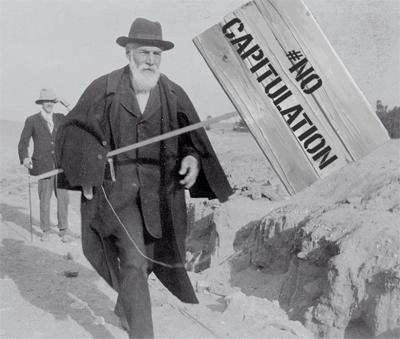
Photograph of Flinders Petrie edited to express support for the USS pension strikes held in 2018. (Photo: Archaeology on Strike https://archaeologyonstrike.tumblr.com/).
Moving Objects – New Directions for Heritage
My concluding thoughts relate to the need to continue to take forward and open up UCL/IoA institutional heritage and archival memory beyond the strike and the internal domains/conflicts of academia in solidarity with new constituencies. Under the sign of protest in its widest sense my final thoughts are with contemporary moral-ethical imperatives synonymous with the current ‘Refugee Crisis’. My reference here being to a strategic return to the origins of IoA which the founding Director Mortimer Wheeler describes as bound up in giving a home to what he described as Petrie’s ‘homeless Palestinian collection’ (Wheeler 1953).
A new exhibition ‘Moving Objects – Voices of Displacement’ planned to open in the UCL’s Octagon Gallery in February 2019 is co-curated with asylum-seekers and refugee groups. The project features objects including items from the Petrie Palestinian collection to reflect on both the mobility and migration of such objects, and the extent to which diverse objects and artefacts can ‘move us’. This task thereby inviting, demanding, requiring different forms of emotional and political engagement with questions of displacement and both our own cultural and institutional complicities and by creating new forward directions of engagement.
The Roman Plebs on strike (Ulrike Sommer)
The first literary record of a strike in Western Europe comes from Republican Rome. Titus Livius (59–17 BC), not overly renowned for historical accuracy, compiled a history of Rome from its very beginnings from the often wildly divergent records preserved by diverse patrician families.
According to Livy’s (Ab urbe condita libri CXLII), in 494 BC, numerous members of Roman working class left the city and established a fortified camp on the Mons Sacer about 2 km northeast of Rome. They complained that while they fought Rome’s external enemies, they fell into debt and were enslaved by the aristocracy. In a touching scene, a veteran bares his battle-scars and the galls left by debtor’s chains and declaims that the liberty of the plebs is only real in war facing the enemy, but not among his fellow citizens.
According to Livy, this act of civil disobedience lead to starvation in Rome. The patricians were also terrified of an attack by the enemy Volscii without troops to defend them. They entered into negotiations. As a result, plebeian tribunes were installed and given sacrosanct status, the concilium plebis was officially recognised and the working class returned to the city. A second secession of the plebs in 450/449 allegedly happened when a member of the ruling Ten (decemvirs) conspired to have Verginia, a plebeian maiden he fancied declared slave-born in order to get her into his power. Her father killed Verginia rather than let her be enslaved, and then led a secession of the plebeian troops to the temple of Ceres on the Aventine. The troops on the Sabine-front joined their cause. In consequence, the Decemvirs were abolished, the Twelve Table Laws adopted and the plebeian tribunes reinstated.
The plebeian activists of the third secession in 287 occupied the transtiberian Ianiculum, a hill that controls the southern approaches to Rome. The occupation ended with the passing of the Lex Hortensia, which gave plebeians full legal equality and accepted the rulings of the popular assembly as law. A possible fourth walkout in 445 BC to the Ianiculum ended with the permission of marriage between commoners and nobles.
A number of historians, starting with Eduard Meyer (1895) have claimed that these reports on peaceful walkouts of a substantial populace of Rome in reaction to oppression by the Patricians are either a complete fabrication of the notoriously unreliable Livy, or that a single event, probably the seccessio of 287, the only one recounted by several authors has been multiplied and embellished (Gary 2005: 158; Mignone 2016: 34). Given the political impact of these walkouts (Breaugh 2013, ch. 2), it seems highly improbable that ruling class authors would invent or embellish them. Instead, Livy hides a clear line of political resistance and rebellion among the tales of patrician valour and derring-do that made it to the schoolbooks later on, as well as personalised accounts of brave veterans and honour killings. Which leads to the conclusion that organised civil disobedience and strikes may have been much more common in ancient history than indicated by written sources altogether and needs to be dug out.


